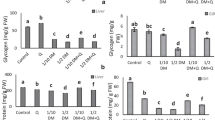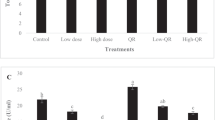Abstract
Concentrations of quercetin in fish tissues were measured for the first time using HPLC-electrochemical detection method. Its identity was also ascertained with UV-photodiode array detection. Quercetin, in aglycone form, was at measurable concentrations in tilapia plasma, liver, and whole body homogenate when fed with diets containing 1% quercetin (aglycone) for 1 or 15 weeks. Hydrolysis with glucuronidase/sulfatase treatment for the purpose of cleaving conjugates did not increase quercetin levels, suggesting that glucoronide or sulfate conjugates are not the major metabolic forms in Nile tilapia (Oreochromis niloticus). No quercetin was detected in plasma of rainbow trout (Salmo gairdneri) or white sturgeon (Acipenser transmontanus) fed commercial diets. The results suggest that quercetin is absorbed in tilapia and that this flavonoid is deposited mainly in aglycone form in the body after absorption.

Similar content being viewed by others
References
Ader P, Wessmann A, Wolffram S (2000) Bioavailability and metabolism of the flavonol quercetin in the pig. Free Radic Biol Med 28:1056–1067. doi:10.1016/S0891-5849(00)00195-7
Bonello P, Blodgett JT (2003) Pinus nigra-Sphaeropsis sapinea as a model pathosystem to investigate local and systemic effects of fungal infection of pines. Physiol Mol Plant Pathol 63:249–261. doi:10.1016/j.pmpp.2004.02.002
Boulton DW, Walle UK, Walle T (1999) Fate of the flavonoid quercetin in human cell lines: chemical instability and metabolism. J Pharm Pharmacol 51:353–359. doi:10.1211/0022357991772367
Dabrowski K, Lee K-J (2001) Quercetin—a new phytochemical in fish diets formulations. Paper presented at the International Triennial Conference & Exposition of Aquaculture, Disney’s Coronado Springs Resort, Lake Buena Vista, Florida, 21–25 January 2001
Day AJ, Williamson G (2001) Biomarkers for exposure to dietary flavonoids: A review of the current evidence for identification of quercetin glycosides in plasma. Br J Nutr 86(Suppl 1):S105–S110
Erlund I, Kosonen T, Alfthan G, Mäenpää J, Perttunen K, Kenraali J et al (2000) Pharmacokinetics of quercetin from quercetin aglycone and rutin in healthy volunteers. Eur J Clin Pharmacol 56:543–553. doi:10.1007/s002280000197
Formica JV, Regelson W (1995) Review of the biology of quercetin and related bioflavonoids. Food Chem Toxicol 33:1061–1080. doi:10.1016/0278-6915(95)00077-1
Hollman PCH, van Trijp JMP, Buysman MNCP (1996) Fluorescence detection of flavonols in HPLC by postcolumn chelation with aluminum. Anal Chem 68:3511–3515. doi:10.1021/ac960461w
Hou YC, Chao PDL, Ho HJ, Wen CC, Hsiu SL (2003) Profound difference in pharmacokinetics between morin and its isomer quercetin in rats. J Pharm Pharmacol 55:199–203. doi:10.1211/002235702487
Jones DJL, Lim CK, Ferry DR, Gescher A (1998) Determination of quercetin in human plasma by HPLC with spectrophotometric or electrochemical detection. Biomed Chromatogr 12:232–235. doi:10.1002/(SICI)1099-0801(199807/08)12:4<232::AID-BMC740>3.0.CO;2-1
Manach C, Morand C, Demigné C, Texier O, Régérat F, Rémésy C (1997) Bioavailability of rutin and quercetin in rats. FEBS Lett 409:12–16
Manach C, Morand C, Crespy V, Demigné C, Texier O, Régérat F et al (1998) Quercetin is recovered in human plasma as conjugated derivatives which retain antioxidant properties. FEBS Lett 426:331–336. doi:10.1016/S0014-5793(98)00367-6
Manach C, Texier O, Morand C, Crespy V, Régérat F, Dimigné C et al (1999) Comparison of the bioavailability of quercetin and catechin in rats. Free Radic Biol Med 27:1259–1266. doi:10.1016/S0891-5849(99)00159-8
Morrice PC, Wood SG, Duthie GG (2000) High-performance liquid chromatographic determination of quercetin and isorhamnetin in rat tissues using β-glucuronidase and acid hydrolysis. J Chromatogr B Analyt Technol Biomed Sci Appl 738:413–417. doi:10.1016/S0378-4347(99)00520-4
Nielsen SE, Dragsted LO (1998) Column-switching high-performance liquid chromatographic assay for the determination of quercetin in human urine with ultraviolet absorbance detection. J Chromatogr B Biomed Sci Appl 707:81–89. doi:10.1016/S0378-4347(97)00574-4
Nieto S, Garrido A, Sanhueza J, Loyola LA, Morales G, Leighton F et al (1993) Flavonoids as stabilizers of fish-oil—an alternative to synthetic antioxidants. J Am Oil Chem Soc 70:773–778. doi:10.1007/BF02542599
Noroozi M, Burns J, Crozier A, Kelly IE, Lean MEJ (2000) Prediction of dietary flavonol consumption from fasting plasma concentration or urinary excretion. Eur J Clin Nutr 54:43–149. doi:10.1038/sj.ejcn.1600908
Piskula MK, Terao J (1998) Quercetin’s solubility affects its accumulation in rat plasma after oral administration. J Agric Food Chem 46:313–4317. doi:10.1021/jf980117v
Plakas SM, Lee T-C, Wolke RE (1985) Absence of overt toxicity from feeding the flavonol, quercetin, to rainbow trout (Salmo gairdneri). Food Chem Toxicol 23:077–1080
Rinchard J, Lee K-J, Dabrowski K, Ciereszko A, Blom JH (2003) Influence of gossypol from dietary cottonseed meal on haematology, reproductive steroids and tissue gossypol enantiomer concentrations in male rainbow trout (Oncorhynchus mykiss). Aquacult Nutr 9:275–282. doi:10.1046/j.1365-2095.2003.00253.x
Rosemann D, Heller W, Sandermann H Jr (1991) Biochemical plant responses to ozone: II. Induction of stilbene biosynthesis in Scots pine Pinus sylvestris L. seedlings. Plant Physiol 97:1280–1286
Shahidi F, Naczk M (1995) Food phenolics: sources, chemistry, effects, applications. Technomic, Lancaster, PA, USA
Tshushida T, Suzuki M (1995) Isolation of flavonoid-glycosides in onion and identification by chemical synthesis of the glycoside: Flavonoids in fruits and vegetables Part I. Nippon Shokuhin Kagaku Kogaku Kaishi 42:100–108
Walle T, Otake Y, Walle UK, Wilson FA (2000) Quercetin glycosides are completely hydrolyzed in ileostomy patients before absorption. J Nutr 130:2658–2661
Weber LP, Kiparissis Y, Hwang GS, Niimi AJ, Janz DM, Metcalfe CD (2002) Increased cellular apoptosis after chronic aqueous exposure to nonylphenol and quercetin in adult medaka (Oryzias latipes). Comp Biochem Physiol C Toxicol Pharmacol 131:51–59
Wittig J, Herderich M, Graefe EU, Veit M (2001) Identification of quercetin glucoronides in human plasma by high-performance liquid chromatography-tandem mass spectrometry. J Chromatogr B Biomed Sci Appl 753:237–243. doi:10.1016/S0378-4347(00)00549-1
Acknowledgments
Part of this paper was prepared with support from the Pond Dynamics/Aquaculture Collaborative Research Support Program (PD/A CRSP), funded by USAID Grant No. LAG-G-00-96-90015-00 and by contributions from the participating institutions. The Aquaculture CRSP accession number is 1290. The opinions expressed herein are those of the author(s) and do not necessarily reflect the views of the US Agency of International Development. Part of this paper was also funded by the United States Department of Agriculture-Cooperative State Research, Education, and Extension Service National Research Initiative (USDA-CSREES NRI) Grant No. 2003-35206-12858.
Author information
Authors and Affiliations
Corresponding author
Rights and permissions
About this article
Cite this article
Park, K.H., de Oca, G.A.RM., Bonello, P. et al. Determination of quercetin concentrations in fish tissues after feeding quercetin-containing diets. Aquacult Int 17, 537–544 (2009). https://doi.org/10.1007/s10499-008-9222-6
Received:
Accepted:
Published:
Issue Date:
DOI: https://doi.org/10.1007/s10499-008-9222-6




